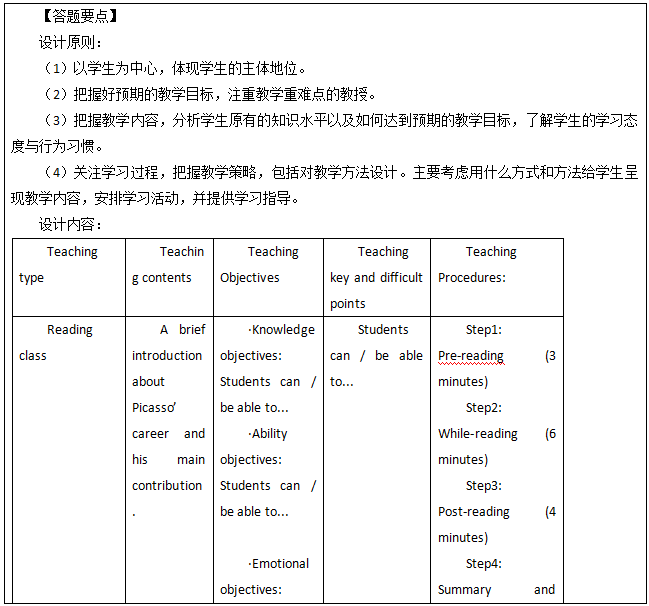2019下半年河南教师资格考试《高中英语学科知识与能力》参考答案(二)
- 时间:
- 2019-11-07 09:46:12
- 作者:
- 尚老师
- 阅读:
- 来源:
- 河南教师资格证考试




【导读】河南教师资格网为诸位考生带来河南教师资格证考试公告、河南范围内各地区关于教师资格证的资讯、新闻、招聘信息、以及政策,更多河南教师资格证相关资讯敬请关注河南教师资格网。
三、教学情境分析题(本大题1小题,30分)
32.【参考答案】
(1)该板书设计的教学目的是通过罗列一系列的单词及其搭配,能够让学生清楚地了解板书中所罗列词汇的具体用法及相应的搭配结构,从而在真实的英语学习中掌握词汇的实际运用。
(2)①体现了有效教学也是一套策略的教学理念。该理念要求教师掌握有关的策略性知识,以便于自己面对具体的情景作出决策。在该板书设计中,教师采用了大括号式的方法,帮助学生整理了词汇的具体搭配及可替换词汇,体现了教学过程中的有效性、策略性;②体现了提供多种选择,适应个性需求的教学理念。高中阶段的英语课程要有利于学生个性和潜能的发展。因此,高中英语课程内容必须具有选择性。在该板书设计中,教师提供了能够适用于该搭配的多种词汇选择,目的在于一方面让学生掌握词汇用法,另一方面能够让学生在真实语境中具备多种选择,满足个体需求;③体现了优化学习方式,提高自主学习能力的教学理念。该板书中并未将词汇及其搭配一一罗列,而是采用了大括号式的方法,这样的方法更加清晰明了,使学生在学习中能更加融会贯通,能够通过自我分析掌握词汇的用法和结构,锻炼了学生的自主学习能力,并能潜移默化地让学生学会利用该种学习方式,从而优化学习。
(3)优点:①通过大括号式的方法,帮助学生整理了词汇的搭配及结构,有益于学生进行知识的联系和迁移,从而掌握多个词汇的具体运用;②通过罗列多个词汇,学生也能够发挥自己的主观能动性,运用自己的自主学习及分析能力,从而加深对词汇的理解。
缺点:①该板书没有标题,板书的标题是一节课知识和内容的纲领性存在,起概括和引领性作用,也能让学生更加清楚了解本节课的核心;②该板书设计中并未突出重难点,高中阶段应掌握的词汇一般难度较大,很明显该教师并未考虑学生学习中的阶段性特征,把一些简单词汇和较难词汇直接混为一体,并未突出本节课应重点掌握的词汇,该做法不利于学生把握本节课重难点。
四、教学设计题(本大题1小题,40分)
33.

【参考设计】
Teaching type: Reading class
Teaching contents: This lesson is from Foreign Language Teaching and Research Press, senior high school, the second book, Module 4, Cultural Corner part. It gives a brief introduction about Picasso’s career and his main contribution.
Teaching Objectives:
(1) Knowledge objectives:
①Students are able to know the different stages of Picasso’s career and his main contribution.
②Students are able to know the main features of Cubism.
(2) Ability objectives:
①Students are able to find the main idea and detailed information about the passage through some reading skills like skimming and scanning.
②Students are able to retell the passage according to the given time.
(3) Emotional objectives:
①Students can foster their interest and desire of learning English, and they can be fond of taking part in class activities.
②Students are able to improve their interest in Western and oriental paintings actively.
Teaching key and difficult points:
Teaching key point:
Students can understand and master the basic knowledge of the reading material correctly.
Teaching difficult point:
Students can foster the interest of learning English and strengthen their interest in painting.
Teaching Procedures:
Step 1: Pre-reading (3 minutes)
(1) Show students some famous paintings in western world, such as The Last Supper, Quernica and so on.
(2) Ask students to watch a short video about Cubism, which mainly introduces the features of this movement.
(Justification: Showing students some pictures of famous paintings can improve their interest in this topic. A short video can help students to know more background information about the passage. )

Step 2: While-reading (6 minutes)
(1) Ask students to read the passage for the first time and finish the following blanks.

(2) Ask students to read the passage for the second time and finish the time line.
Time Stages of Career
At the age of 10 ______________
At the age of 16 ______________
From 1902 to 1904 ______________
From 1904 to 1906 ______________
(3) Ask students to talk about the following questions in group of 4. Four minutes for them to discuss.
① What can you see and how do you feel when you look at the famous painting Quernica?
② What does Picasso want to express through this painting?
(Justification: Filling the blank helps students to know the main information of the passage and helps them to improve the reading skills. Time line will help them to know more detailed information about Picasso’s career. Questions can improve student’s critical thinking. )

Step 3: Post-reading (4 minutes)
(1) Ask students to retell the passage according to the time line and blank.
(2) Ask students to share their favourite painters and the works of the painters. Four students a group and two minutes for them to discuss. After two minutes, ask some of them to share in front of the classmates.
(Justification: Through retelling, students’ understanding of the passage will be strengthened. The final discussion will help them to improve their speaking and organizing ability.)

Step 4: Summary and Homework (2 minutes)
Summary: Invite two students to be the teacher assistants to make a conclusion for the class.
Homework:
(1) Make a resume about the students’ favorite painter and show it next class.
(2) Search more information about Cubism and collect more representative works.
(Justification: Summary can make students know the main information about the class. Homework can help students to consolidate the knowledge that they have learned in class and use them in daily life.)



























